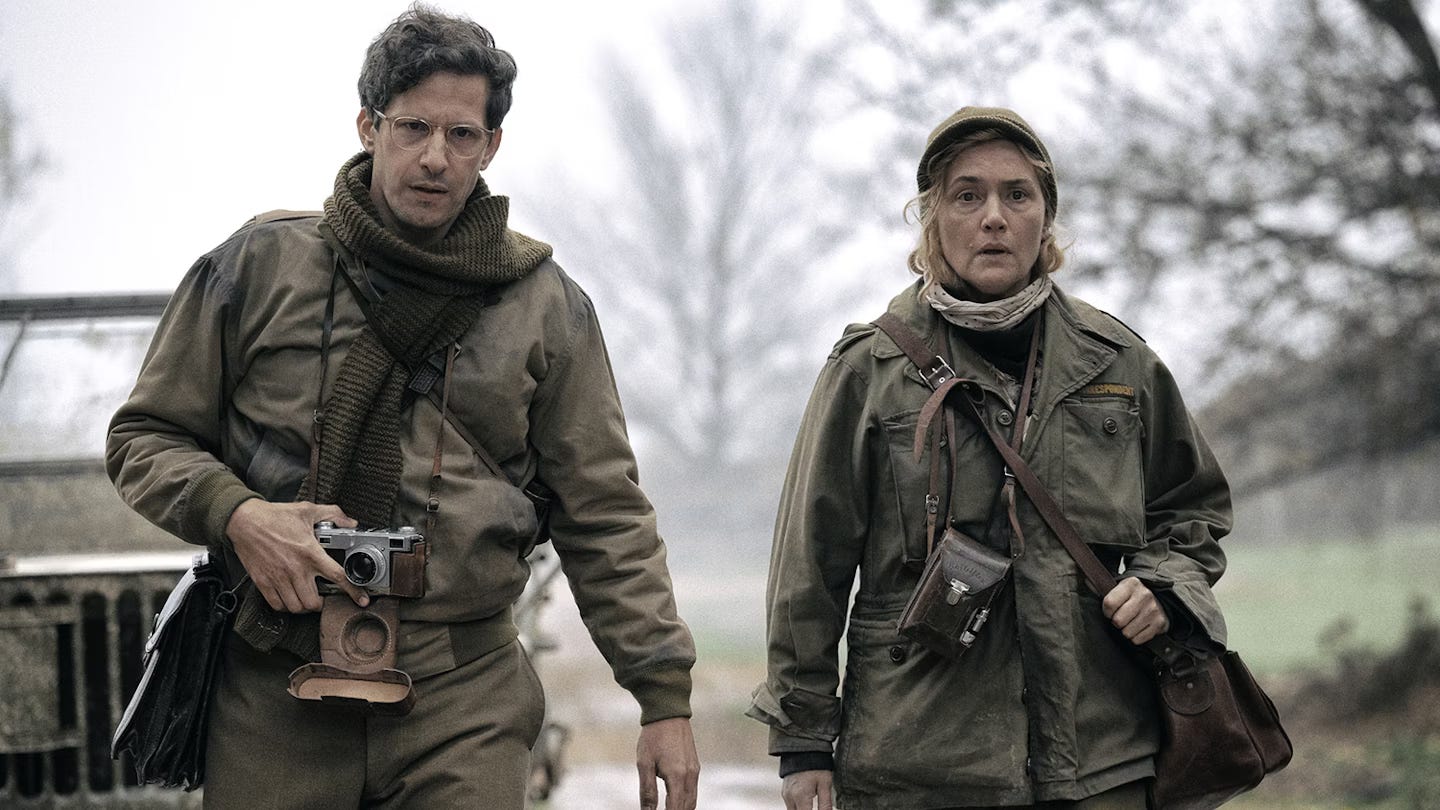Lee
Kate Winslet gives an emotionally intricate performance as legendary war correspondent Lee Miller, who morphed from frivolous bohemian to grim witness to history.
It’s interesting how so many impactful historical figures started out as frivolous people. Lee Miller was an American who traipsed across the globe as a top model in the 1920s and ‘30s, gallivanting alongside French and British artists, enjoying the bohemian lifestyle of the era. Later she decided to try her hand behind the camera, too.
“I'd rather take a picture than be one,” she explained.
Eventually, she became one of the most legendary war journalists who witnessed the worst of World War II, from the London Blitz to the devastation of Paris, the inhumanity of the concentration camps and even, infamously, taking a bath in Adolf Hitler’s own bathtub at the end of the war.
As portrayed by Kate Winslet in “Lee,” the new biopic focusing on her wartime experiences, Miller was a complex figure capable of great contradictions. She was smart and headstrong, protective of her friends and caustic of authority figures, perceptive but also self-delusional. She drank and smoke heavily, and over the course of the movie ages from sprightly ingenue to worn cynic.
Written by Liz Hannah, John Collee and Marion Hume (from a story by Hume, Collee and Lem Dobbs) and based on a biography written by Miller’s own son, Antony Penrose, “Lee” is directed by Ellen Kuras, a veteran cinematographer who branched into directing for television and makes her narrative feature debut here. As you might expect, it’s a fantastic-looking film full of the glory and grime of 1940s Europe.
As the story opens Lee is enjoying the French countryside with her pals, drinking in the morning and the women sunbathing topless. At first I thought this a prurient addition, until we realize this moment was captured by Lee’s camera. Many of the most memorable scenes in the movie are just such recreations.
She meets Roland (Alexander Skarsgård), a charming Brit painter and curator from wealthy means, and they play a testy game where they assess each other’s best, and worst, qualities. Soon they’re an item.
With the start of the war, he gets a job using his artistic skills at camouflage, while she lands a gig taking photos of the bombing devastation for British Vogue magazine, led by the inimitable Audre Withers, played by Andrea Riseborough, one of my favorite cinematic chameleons. They form a fast friendship based on professional respect.
When it becomes clear the Allies are about to invade Europe, Lee begs to go but is denied permission by the British military because of her sex. Her colleague, David Scherman, a reporter for Life magazine, suggests she goes with the Americans instead, setting off a long collaboration as friends and partners.
(Scherman is played by Andy Samberg, in a carefully bookended and non-comedic performance, who adds notes that Scherman’s feelings for Lee were not entirely platonic.)
From getting caught in the middle of firefights to a harrowing visit to the frontline hospitals as doctors hack off limbs by the dozen per day, Lee gets a fast education in what war is really about. Everywhere she goes she takes her beloved Rolleiflex camera (ironically a German make), the sort hung around the neck so the photographer peers into the viewfinder from above. With this instrument, iconic historical images were captured.
Eventually Scherman and Miller make it all the way to the heart of Germany, sweet-talking or bribing their way into places holding the horrifying secrets of the Third Reich. Kuras, with her practiced photographer’s eye, shows us how each image was perfectly composed, blending journalism and art.
Marion Cotillard, Noémie Merlant and Vincent Colombe play notable friends of Lee’s, seen before the war and after its devastation.
The movie uses as its framing device an interview with Lee at her Farley Farm House in 1977, now an old woman who drinks non-stop. A young writer, played by Josh O'Connor, has come to uncover her forgotten past as a war correspondent. They look over her photographs, many of them unpublished, and trade questions and barbs.”
All interviews are interrogations. The good ones, anyway,” she says acidly.
The musical score by Alexandre Desplat (“The Shape of Water”) is haunting and understated, sometimes just a few plucked notes that drop like stones into still water, their exquisite reverberations tempering the dark mood of the film. Everything is anchored by Winslet, of course, who gives Lee a bullish sort of grace.
The war left Lee Miller irrevocably changed, as it surely did everyone who touched those terrible events. Rather than just be a victim or another perpetrator of violence, she choose to use her keen eye and obstinate nature to chronicle what she saw — what needed to be seen.





